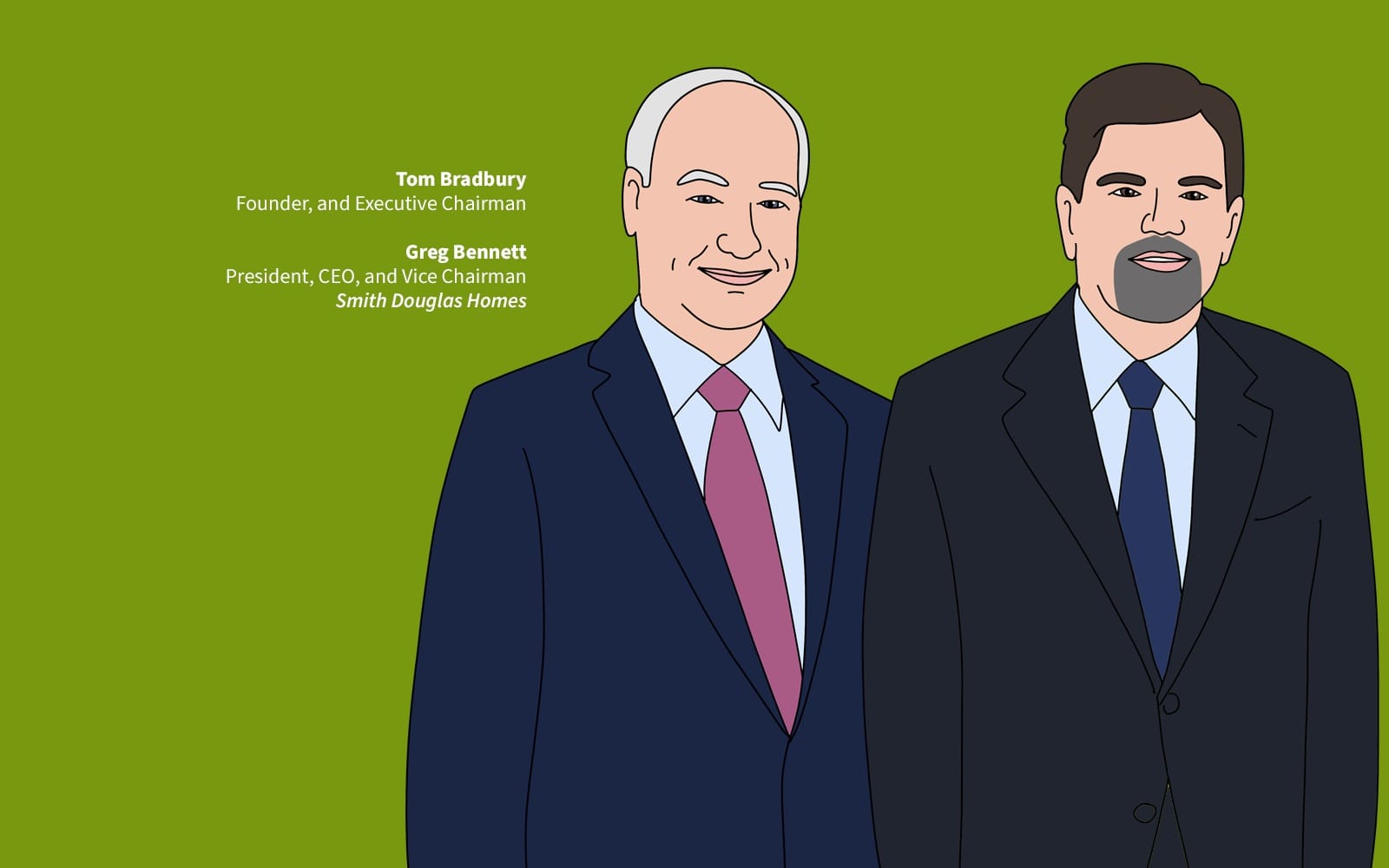Leadership
SDHC: Forged In Adversity, Resilient By Design, Bold By Nature
In Q2 2025, SDHC shielded itself from the drag of housing’s slowdown with two bold market expansions—and proof that its practiced operating model is built to withstand volatility.

In what’s shaping up as one of the most unforgiving home sales environments in over a decade, Smith Douglas Homes Corp. (NYSE: SDHC) posted Q2 2025 results that didn’t just outrun a broader industry tide — they reasserted the company’s confidence in its growth thesis.
At a time when most homebuilders are scaling back, defending margins, and bracing for continued affordability headwinds, Smith Douglas is making offensive moves.
The company revealed in its earnings call on August 6 that it is entering both the Dallas-Fort Worth and Gulf Coast of Alabama markets through greenfield startups. It's a strategy that flies in the face of the prevailing caution.
This audacity is not impulsive. It was practiced.
For the better part of a decade leading up to its January 2024 IPO, Smith Douglas founder Tom Bradbury and his team rehearsed for life as a scaled public enterprise. They did it by building an operational model and business culture for resilience, long before they needed to prove it to Wall Street.
That foundation now shows up in results, notably in Q2’s financial and operational performance:
- Home sales revenue of $223.9 million (+1.35% YoY),
- Closings of 669 homes,
- Gross margin of 23.2%, at the high end of guidance,
- Controlled lots up 57% YoY,
- Community count up 23%, to 92.
CEO Greg Bennett credits the strength to the company’s core operating principles:
We remain intensely focused on operating elements that are within our control, which include making our homes as affordable as possible while giving our buyers the choice and customization they desire."
Smith Douglas’ average sales price came in at $335,000, among the lowest of public builder peers. At that entry-level sweet spot, it leaned into incentives, not as margin giveaways, but as traffic converters and confidence builders. Executive VP and CFO Russell Devendorf confirms:
We started to implement a 5/1 ARM at a 3.99%, and it's been pretty good from a traffic standpoint."
The strategy? Pacing over pricing.
We're pace over price," Devendorf tells analysts. "So it's clearly a matter of just leaning into incentives to the extent that it's needed to drive that pace."
That might spook investors focused on short-term margin erosion. And it did—SDHC’s stock dipped -2.1% on the day of the earnings call. Wolfe Research analyst Trevor Allinson notes that while EPS of $0.25 beat estimates by 19%, the Q3 gross margin guidance of 20.5%-21.5% came in ~135 bps below consensus. But Allinson doesn’t dismiss the strategy. He sees purpose:
SDHC must drive volume to keep its R-Team production machine primed or risk inefficiencies once demand improves and production accelerates. Burning through commoditized land will allow SDHC to take advantage of potentially reset land pricing moving forward."
Here’s the real story: SDHC is playing a different game, one they’ve long prepared for.
That includes:
1. Affordability-Centric Design
Bennett and Bradbury have always positioned Smith Douglas as a builder for working families—entry-level and downsizing buyers priced out of existing inventory or bespoke new construction. The ability to deliver personalized homes at below-median pricing isn’t a recession play; it’s the company’s identity.
2. People-First Execution Culture
As Bradbury often puts it:
Good, better, best. You never let it rest, 'til the good is better, and the better is best."
It’s not just motivational—it's structural. The R-Team model puts full-cycle responsibility on operational pods, empowering local teams and instilling accountability. When Devendorf explains the cost of market entry in DFW, he doesn’t start with SG&A metrics. He starts with people:
The two folks that are going to be heading up these operations are internal folks that have been at the corporate level for a long time and get how we do things."
3. Velocity-Driven Build Cycle
While the industry norm still struggles with 90-120 day cycles, Smith Douglas’ average build time, excluding Houston, dropped to 54 days in Q2. That’s no fluke—it’s the result of process discipline and trade alignment. Bennett describes it as a loop of mutual trust:
Our trades know they’re getting a commitment of starts, and that allows us to be more reliable in our assembly process."
That velocity helped drive a YOY drop in the company’s cancellation rate to 10%—a quiet but powerful indicator of buyer commitment and operational trust.
Even more telling, SDHC’s spec levels—typically a liability in a slow market—became an asset. Devendorf explains:
We do have some higher levels of inventory... but we've just been selling at a higher spec rate. So backlog turnover has obviously increased—and we're getting some higher spec sales."
Geographic Expansion: Bold, But Measured
Dallas-Fort Worth and the Alabama Gulf Coast may be contrarian moves, but they're calculated. Devendorf shares:
There was a really good opportunity to pick up finished lots... with some pretty low deposits. So really limits the risk, but it's a good time for us to start taking advantage of some opportunity."
Bennett adds,
We've been working to secure several finished lot positions in DFW over the last six months and expect to start selling by year-end."
3,000 Deliveries in Sight
At the start of 2025, Smith Douglas signaled a bold target: 3,000 home deliveries for the year. That guidance remains intact—and within reach. "3,000 is in our sights," said Devendorf. "We certainly have the lot positions. We've got the community count. So it's really going to depend on demand for us." He acknowledged that incentives may continue to weigh on margins in the short term, but reaffirmed the company’s intent to prioritize sales velocity to meet delivery goals: "It's not a construction issue. Our cycle times actually continue to improve. It's really just trying to hit a price that can get that demand going."
Risks Remain, But Confidence Holds
Despite strong cycle times and demand-side momentum, SDHC isn’t blind to headwinds. Gross margins are under pressure from prior land inflation and ongoing incentives. Guidance for Q3 closings (725–775 homes) and ASP ($330,000–$335,000) reflects a tightrope walk.
Still, SDHC’s asset-light model, lean balance sheet (12.1% net debt-to-cap), and strong liquidity position ($189 million revolver availability) give it room to act while others retrench.
What may look like an outlier in Q2 2025 is actually the product of a decade of intentional build-up. From its practiced IPO readiness to its repeatable operating cadence, Smith Douglas stands as a case study in durable growth, not despite volatility, but because of it.
As Allinson of Wolfe Research writes:
Pay me now or pay me later."
SDHC has opted to pay now and position for advantage when the cycle inevitably turns.
MORE IN Leadership
Capital, Land, and People Collide In Still Unsolved Hard Problems
Homebuilders face a grind where money is scarce, land sticky, and people harder than ever to engage. The Focus On Excellence summit tackles them head-on.
Homebuilder Caution Mounts As KB Home Trims Its Forecast
Two days, two giants, two sobering outlooks. KB Home joins Lennar in signaling deepening headwinds on both the cost and buyer sides of the market.
Sorry, Robots -- Humans Are Still The Future Of Homebuilding
Skillit CEO Fraser Patterson argues that the homebuilding industry’s biggest risk isn’t a lack of robots—it’s a shortage of accessible, skilled frontline workers. Richard Lawson has the full interview.
